Brian Brenner, P.E., F.ASCE, is a professor of the practice at Tufts University and a principal engineer with Tighe & Bond in Westwood, Massachusetts. His collections of essays, Don’t Throw This Away!, Bridginess, and Too Much Information, were published by ASCE Press and are available in the ASCE Library.
In his new Civil Engineering Source series, “More Water Under the Bridge,” Brenner shares some thoughts each month about life as a civil engineer, considering bridge engineering from a unique, often comical point of view.
Suspension bridges are big and urban. At least, that’s how I see them. Growing up, my folks would drive from the northern suburbs to visit New York City by driving across the George Washington Bridge. I sat in the back seat, gawking at the spectacle.
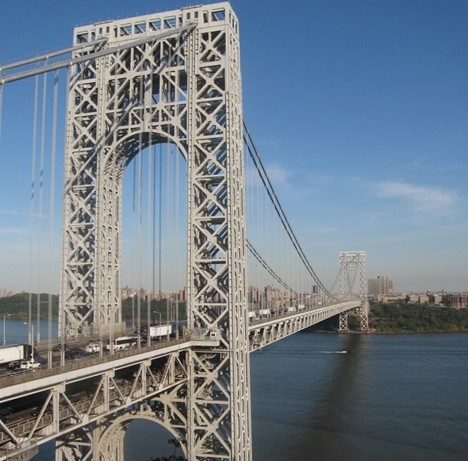
The George Washington is not an average suspension bridge. It is big and monumental but with exposed truss-framed towers. When it opened in 1931, it was the world’s longest span, and to this day it is #42 on the list of top span lengths. Unusual for a suspension bridge, the structure appears massive and not slender. This visual impression is due to the truss towers, an unusual feature for suspension bridges.
The towers were originally to be clad in granite. The planned stonework required more tower strength to support the weight of the heavy cladding. As construction was concluding during the Depression, costs needed to be cut, and the stone was deleted. But the massive, exposed truss framing remains, contributing to the bridge’s industrial appearance. Later bridges designed by the chief engineer, Othmar Amman, such as the Whitestone and Verrazzano bridges, were similarly grand but with a more sleek and polished appearance.
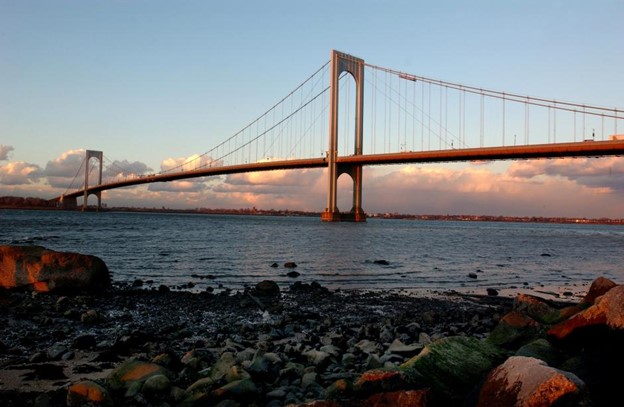
The experience of driving across the George Washington Bridge into Manhattan is one of transition. The northern approaches are via parkland perched high atop the Palisades Cliffs. When you get to the bridge, it is at a well-defined boundary between the cool forest and the dense city. On the bridge, the deck is very wide and always busy. The sweeping views high above the river are of a seemingly endless city of tall towers that stretches onto a hazy horizon.
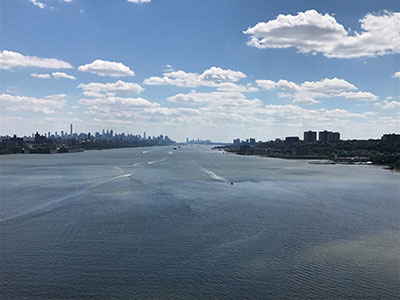
Although the George Washington Bridge is massive, it does not seem separate from the city landscape but a part of it. This is true for many large suspension bridges, such as the Walt Whitman Bridge in Philadelphia, the Vincent Thomas Bridge in Los Angeles, and the Bosphorus Bridges in Istanbul.
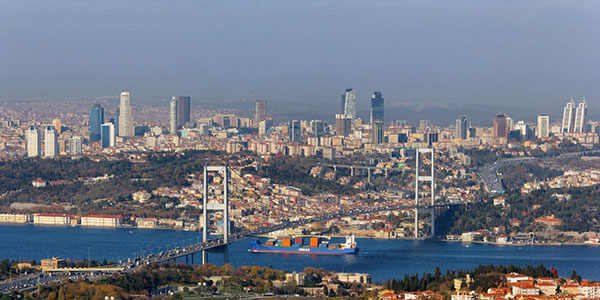
There are other suspension bridges in rural areas that provide a different visual impression. They seem separate from their surrounding landscapes. These bridges can be sighted at remote locations, and they are often startling to see. At these crossings, I am always surprised and delighted. The experience is of a suspension bridge, which is always excellent. But the bridges look out of place. There is no big city attached, only farmland, woods, or desert.
One of the most surprising bridges of this type is the Deer Island Bridge in Maine. The bridge crosses Eggemoggin Reach, connecting Little Deer Island to the mainland. It is a large bridge with a relatively long span of over 1,000 feet. It was built in 1939 with a slender plate girder and a narrow deck, similar to the doomed first Tacoma Narrows bridge that was built a few years later. Like the Tacoma Narrows Bridge, the Deer Island Bridge deck moved a lot in the wind. Unlike the Tacoma Narrows Bridge, which lasted only four months, the Deer Island Bridge remained intact long enough to be reinforced with diagonal stay cables and other strengthening measures to avoid collapse.
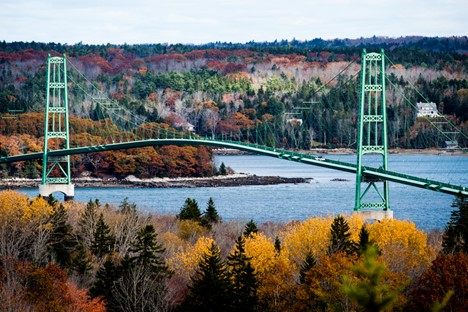
Driving across the bridge from the north is startling because there are no visual cues of what is to come. The approach roads are rural, winding, and pleasantly treed. As you drive south toward the crossing, you are covered by a forest canopy for many miles. Then suddenly, with little visual warning, you are on the soaring span, crossing on a large suspension bridge which seemingly appears out of nowhere and out of context. This is great fun, to encounter a large bridge that mysteriously appears in the middle of the forest.
A branch of the Lake Oroville reservoir in Central California is crossed by a large suspension bridge that is also seemingly in the middle of nowhere. The reservoir is formed by a dam at the west edge of the lake near the city of Oroville. To the east, roads continue up and into remote foothills and through grasslands. One of the roads, California Route 162, crosses a branch of the lake on the Bidwell Bar Bridge. The structure is a large suspension bridge built in 1965 with a main span of 1,108 feet. It was a replacement for a smaller, historic suspension bridge that is now preserved in a park.
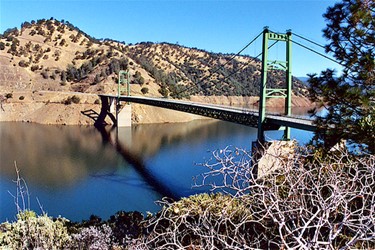
The bridge has become a visual guide to the impacts of climate change. The structure is built at a high elevation above the flooded canyon floor below. But typically, you can’t see that. When the reservoir is full, the concrete pedestals supporting the towers are almost covered by water. But during ongoing California droughts, the water level in Lake Oroville can drop, exposing the steep canyon walls that the bridge is perched on.
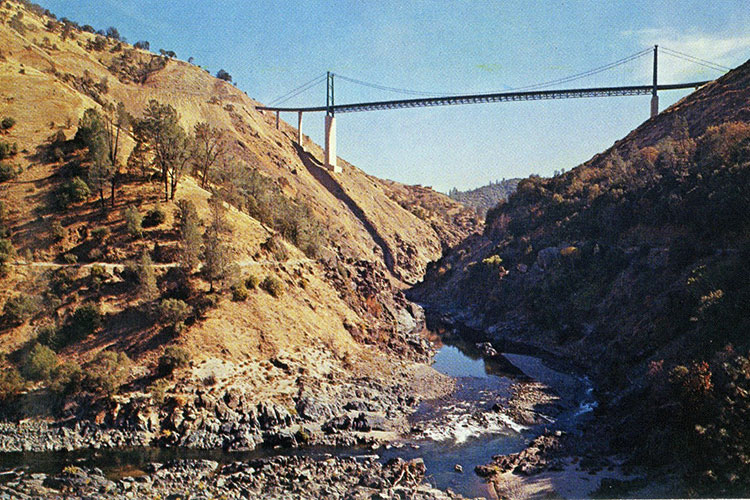
More arresting are impacts from wildfires. A large fire burned in the area in September 2020. Photographers captured the bridge spanning in a hellish landscape.
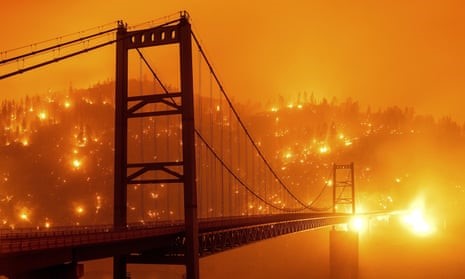
On what we hope is a more average day, without drought or flames, the Bidwell Bar Bridge is a remote delight. It is a giant urban-looking bridge missing its accompanying city.
Another bridge in the wilds can be found in northern Arkansas, where the Beaver Bridge crosses the White River in the town of Beaver. The bridge has a 554-foot span and all the trappings of a big suspension bridge, but with none of the usual urban surroundings. Its local nickname is the “Little Golden Gate Bridge.” Vehicles cross on a single, narrow, wood-decked lane.
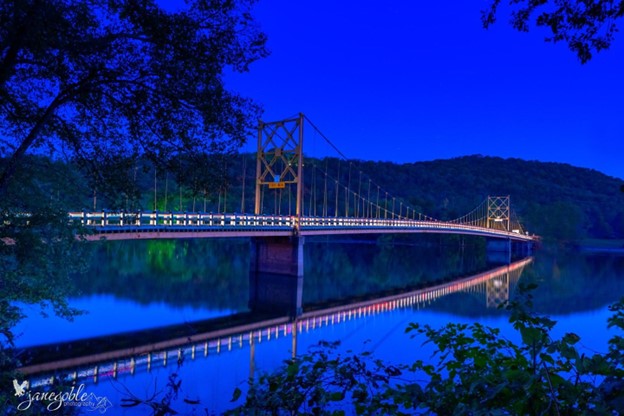
The beautiful historic bridge remains in service with weight restrictions. Over the years, the structure has been rehabilitated several times. In 2018, an overweight bus crossed the bridge resulting in noticeable deflections. You can watch the bus crossing the bridge here. After the bus safely made it across, the structure was temporarily closed and inspected for potential damage.
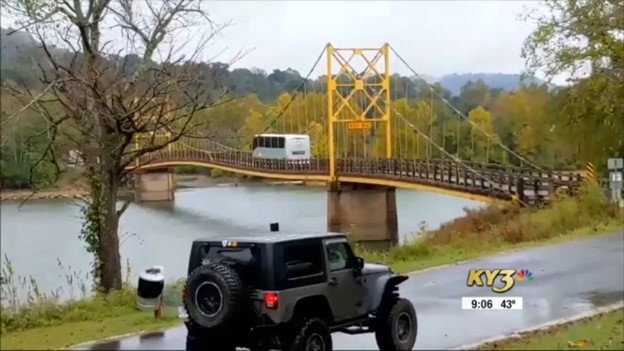
One of the most interesting places to find a suspension bridge is in the Ozark Hills of Missouri. A bridge was constructed across the Little Niangua River in the rural town of Roach. It was built in 1931 after completion of the Bagnell Dam, which formed the Lake of the Ozarks. The little suspension bridge has the classic suspension bridge shape with a unique design. It is a self-anchored bridge where cable tension forces are resisted by the deck. So, there are no large concrete abutments, anchorages, or piers on the riverbanks.
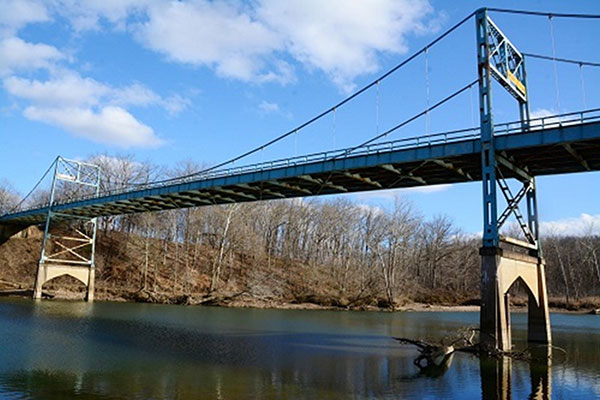
Until 2017, the bridge carried Missouri Route J across the river, and what a startling drive that must have been. Route J traverses a pleasant pastiche of woods and farmland. The road curves to the river and unaware drivers would find themselves briefly suspended above the water. Missouri DOT rerouted Route J to a modern but nondescript new beam bridge immediately upstream, and the suspension bridge was slated for demolition. The DOT’s office of historic preservation offered the bridge to an organization that offered to maintain it.
Local fans of the bridge created an organization, Greens Mill Historical Bridge Inc., to preserve the bridge. At the start of 2023, MoDOT transferred ownership of the bridge to the group. Now efforts are underway to construct park facilities on the shores to provide access for recreation and gatherings. Having a party on a nice, remote suspension bridge sounds like a unique opportunity, and this will be possible at Greens Mill.
The Greens Mill Society represents a successful local effort to preserve a unique historic bridge. Unfortunately, smaller suspension bridges are increasingly becoming a thing of the past. Of the four described above, it is likely that none would be built as a suspension bridge if designed today. Bridge types selected at these crossings would probably include beams, arches, or cable-stayed bridges. Smaller suspension bridges are increasingly being replaced. Like covered bridges, the bridge technology has passed them by. The structures that remain are historical treasures that tell a story of a different time and place. They are even more of a treasure when seen in the wilds far away from the big city. They are always a delight to encounter, and the landscape benefits from their preservation.



